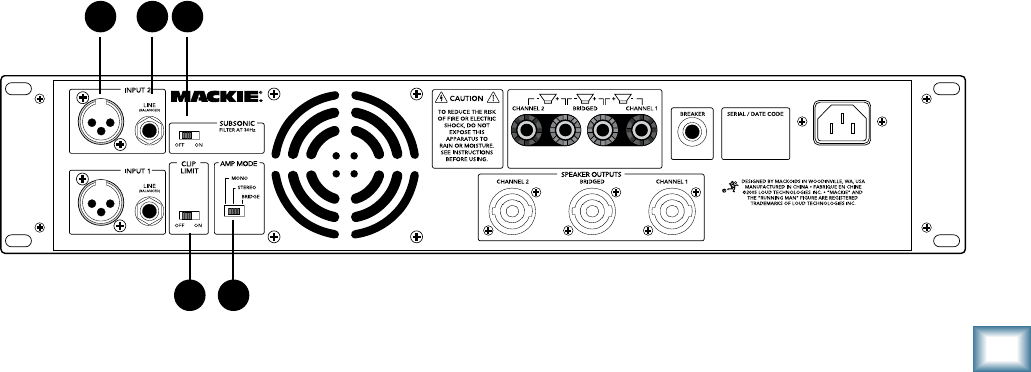
9
Owner’s Manual
Owner’s Manual
7 8
9 10
6
Rear Panel Features
6. XLR INPUTS
These inputs allow you to connect balanced XLR
plugs.
These are wired conventionally, with pin 2 hot, pin 3
cold and pin 1 ground.
7. 1/4" INPUTS
These inputs allow you to connect balanced 1/4" TRS
or unbalanced TS plugs from line-level sources.
Use balanced connections where possible, as these
offer better rejection of noise than unbalanced lines.
Use high-quality, three-conductor shielded cable for
balanced connections. The better the shield, the better
the audio signal is protected from induced EMI and RFI.
8. SUBSONIC FILTER
Turn this switch on to engage a low-frequency cutoff
(high-pass) filter at 30 Hz. The frequency range below
30 Hz is attenuated.
The amplifiers can amplify signals below 20 Hz, but
most speakers can’t reproduce frequencies that low.
By engaging the SUBSONIC FILTER, you allow the
amplifier to power only the frequencies you can hear.
In addition, this filter can reduce low-frequency stage
noise (footsteps) and accidental microphone pops that
could damage a loudspeaker.
Leave this off if you are powering a subwoofer, or if
your speakers can reproduce low frequencies such as
the kick drum range.
9. CLIP LIMIT
When engaged, the CLIP LIMIT switch protects your
loudspeakers from the effects of clipping. It is designed
to be virtually transparent, meaning you probably won’t
even notice any audible difference when the switch is
turned on.
We recommend that you leave this switch on at all
times. However, if you are working at quiet levels, or you
have already placed a compressor/limiter in the signal
path, you can leave the CLIP LIMIT switch off.
10. AMP MODE
This switch determines the input signal routing
within the amplifier. For most applications, you will
use the STEREO setting. However, some applications
might be better suited for using either the MONO or the
BRIDGE setting.
STEREO: This is the normal position used when
amplifying stereo signals. This mode accepts separate
left and right inputs (1 and 2), and routes them to the
CHANNEL 1 and CHANNEL 2 outputs. Each channel’s
Level control adjusts the gain for its own channel, and
each channel is independent.
MONO: This mode is used when you want to send a
mono signal to both outputs. It accepts a single input
(INPUT 1), and routes it to both the CHANNEL 1 and
CHANNEL 2 outputs. Each channel’s Level control
adjusts the gain for its own channel.
BRIDGE: This mode accepts a single input (INPUT
1), and uses both amplifier outputs to double the power
to one speaker. Use the Channel 1 Level control to
adjust the gain (turn the Channel 2 Level control all the
way down). The hookup diagrams show how to connect
a speaker in Bridge mode.


















